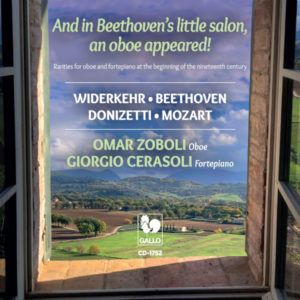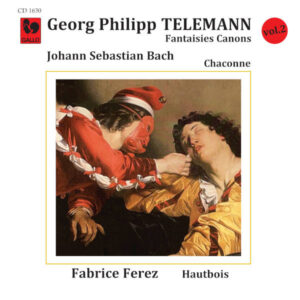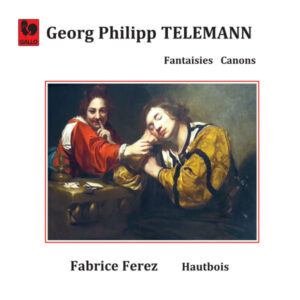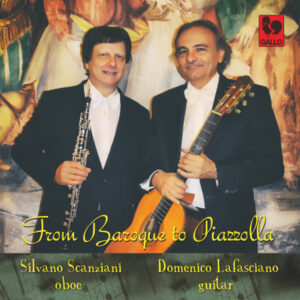Extraits / Excerpts
VIVALDI – MARCELLO – TELEMANN – ALBINONI – UN OBOE NEL « TEATRO DEGLI AFFETI » – OMAR ZOBOLI – ENSEMBLE « IL FALCONE »
Alessandro MARCELLO : Oboe Concerto in D Minor, S. Z799: I. Andante e spiccato – II. Adagio – III. Presto – Antonio VIVALDI : Oboe Concerto in C Major, RV 451: I. Allegro molto – II. Largo – III. Allegro – Georg Philipp TELEMANN : Oboe Concerto in E Minor, TWV 51:e1: I. Andante – II. Allegro molto – III. Largo – IV. Allegro – Johann Gottlieb GRAUM : Oboe Concerto in G Minor, GraunWV Cv:XIII:144: I. Allegro – II. Andante – III. Allegro moderato – Georg Philipp TELEMANN : Trio Sonata in C Minor for Oboe, Viola and Basso Continuo, TWV 42:c5: I. Adagio – II. Vivace – III. Affettuoso – IV. Allegro – Tomaso ALBINONI : Concerto a 5 in B-Flat Major, Op. 9 No. 11: I. Allegro – II. Adagio – III. Allegro.
Omar Zoboli, Hautbois – Ensemble « Il Falcone » : Pablo Perrone & Gian Andrea Guerra, Violons – Guido De Vecchi, Alto – Daniele Bovo, Violoncelle – Federico Bagnasco, Violone – Paola Cialdella, Clavecin
DIARY OF A MUSICAL JOURNEY (by Omar Zoboli)
Prologue
In the Baroque period the great theater is born where music becomes a space to stage the emotions we all know.
Studying and playing these pieces charged with history, I became by steps a “persona”, the “mask” of an actor and a singer conceiving the orchestra as the stage to represent musical plots and affections.
In that wordless theater the consort of the instruments performs as a casting engaged in conversation, the interplay of the emotions acquiring a real dimension capable to bring us surprisingly close to the mind of the composer and even to the place where he lived.
[show_more more= »Afficher la suite » less= »Masquer la suite »]
Alessandro Marcello
Andante e spiccato, first Movement. The oboe enters the stage with elegant and noble demeanor, perhaps such as a rich Venetian patrician, moving in theatrical fashion as if in a Molière’s play, cast in the formal style of Benedetto Marcello or Baldassarre Castiglione.
The oboe “gentilhomme” introduces himself in the first two phrases, engages in a dialogue with the other instruments and finally leads towards a consensual ending in agreement with the strings.
Adagio, one of Marcello’s foremost compositions, also because of Bach’s arrangement, is an invitation to contemplate the architectural and formal beauty of this music. As in the first movement, a concise introduction by the strings serves as prelude to the expression of more intimate feelings along the concert. (N.B. Although I prepared several versions with some of my unconventional variations loosely inspired by Bach’s style, during the recording session a new, much simpler, near improvised version sprung up unexpectedly, as if the baroque but simple and rustic architecture of the little church where we were playing had asked for a token of its presence).
The last movement, Presto, conveys the audience to a merry dancing in a homely set where nobles and bourgeois join in to celebrate cheerfully.
Bach was so fascinated with the Italian mood of this music that he took pains to provide wonderful embellishments and alternate harmonic commentary of his own.
Antonio Vivaldi (or the “unbearable lightness of the musical dialogue”)
We are recording at Premanico, a few kilometers from Genoa, a village built in the hills of the hinterland to protect itself from pirates’ raids. We play in its charming baroque church, a perfect setting for quiet work, the door opened on the churchyard basked in the warmth of a gorgeous afternoon. We rehearse and discuss the character of a section. I strive to imagine how the Red Priest might have worked with his pupils on some phrases, particularly the one called “Pelegrina dell’oboe”.
The didactic aspect of his music blends here with the expressive: in every movement of this concerto, in every single oboe solo phrase, Vivaldi changes register and provide the interpreter with different ways to “recite” the emotions. Vivaldi must have given dynamics instructions to the “Pelegrina dell’oboe” and maybe even played her that part on his violin? The frequent virtuoso “coloraturas” of the oboe are set out with great lightness for the understanding and enjoyment of teenagers otherwise confined into the hardship of their stern college life. “Playing”, therefore, like “spielen”, “play”, “jouer”, “giocare”, as if with a toy, with a little oboe, probably a high-pitched Denner, very agile and fast.
This image helps me to enter the spirit of that deceitfully simple but deep music: a cheerful Allegro, with dynamically startling “forte” and “piano”, then the enchantment of a scented Adagio spelled by a few terse measures, and eventually the Allegro “alla rustica” for the joy of simple folks and for little girls to dance upon (some of them perhaps hosted by the Pietà hospital!).
Graun and Telemann (or the tense dialogue of the “Sturm und Drang” in a protestant spirit).
From the imaginary travel diary of Messer Florian, merchant / bourgeois / Venetian gentleman, and Messer Florian’s brother who opened the first public Café in St Mark’s Square.
7th September 1731
“Arrived tonight in Leipzig, with loads of silk and spices.
At the hotel where the diligence stopped, tasted the famous beer, the sauerkraut, the game. The following day the scores were given to Mr. Bach.
In the evening, music at Zimmermann’s Café: Mr. Bach performed tastefully and skilfully at the harpsichord before a beautiful concert by my Venetian friend Marcello and one by Mr. Vivaldi.
Then the orchestra: we could admire Mr. Gleiditsch at the oboe in a nice concert by Mr. Graun, passionate and elegant, with a sweet pastoral ’andante’ in the middle. “
Who knows if Telemann played that night, and if Zelenka was also there with his violone?
We do not know whether G. Ph. Telemann was at Zimmermann’s Café. In his E minor concerto, however, he figures a world where the emotions seem to be portrayed at a distance, almost officially, in a suitable and orderly arcadian way.
Andante. Well-dressed people meet here: at the beginning of the concert voices are heard absorbed in conversation but nonetheless attentive to the comments of their host, the oboe.
The second movement, Allegro, sketches a hunting scene suspended a while for the hunters to catch their breath before closing in upon the prey.
In the Largo we find ourselves in the drawing room of a “Lustschloss” – a country residence where the guests converse politely enjoying tea and pastries.
In the following Allegro something unforeseen happens. People run around hurrying as if to take cover before the storm. Or have they had disturbing news about the danger of an announced battle? Or is it something concerning their gracious host maybe distressed by his favorite paramour’s moods? Telemann‘s music ends as if running away and leaves us at the side of his beautiful painting, behind the scenes of our own inner musical theater. As in the lithograph “Print gallery” by M.C.Escher we find ourselves standing out of the sketch but at the same time still inside the emotion inspired by the drawing.
Tomaso Albinoni
Albinoni’s baroque music looks more stylized, almost classic in a way that reminds me of the architect Borromini and the churches he built in Rome.
In the first and third movement, the dialogue between the soloist and the “tutti” could be best expressed as a choreography: the melodies seem to be dancing!
The Adagio calls to the fore the oboe and intertwines its strains with the strings in the manner
of a “concerto grosso”.
Telemann Trio Sonata
Here we find ourselves in a private family circle of noble ascent.
We witness the scene and listen unseen to their conversation.
They drink coffee, they taste a sweet delicious wine, and we hear them talking graciously, now and then more excitedly but always stately.
Like a Vermeer’s painting of a room: we peek inside a household guessing the plot of those lives while loosing ourselves into the fabric of an enthrolling musical dialogue.
What is hiding behind the precise sketches of these people, behind the perfect profile of Telemann’s musical phrases?
[/show_more]
- Catégories
- Compositeurs
- Interprètes
- Booklet












